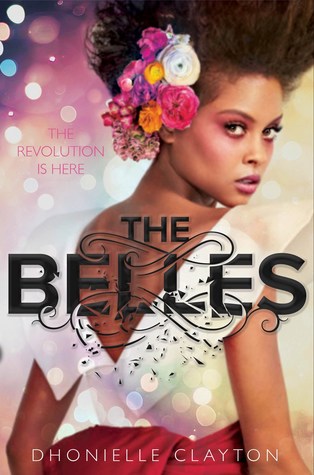The last fifty pages of The Belles took me as long to read as the rest of the book, because I didn’t want the story to end. Plus, the tension was unbearable. There were so many betrayals and revelations packed into the last glittering moments, which is impressive, because the other 375 pages weren’t slow. Not by a long shot.

From page one, the entire book was a lavish, gorgeous feast for the senses. This world built around beauty did not disappoint: from dresses to carriages to tea sets to hairstyles, this was an utterly sumptuous read. But it’s the flaw that draws the eye—the gap between the teeth, the well-placed mole—and the empire of Orleans at first seems to have a charming one. Everyone needs beauty. Everyone needs the magical purveyors of beauty, the Belles.
The first note of foreboding is a wish Camellia has from her now-deceased mother: “The people of Orleans hate themselves. You must change that.” Camellia believes that her path to fulfilling her mother’s dream is to become the favorite, the greatest of all the Belles in the land.
The Belles, though told they are sisters, are made to compete against one another to be “the favorite, “and are judged for performing their beauty (not possessing it). That is some scathing cultural criticism and I am here for it. Women are inevitably made to compete with others by the way society forces comparison, which inhibits a feeling of sisterhood. And the performance of beauty—the creation of beauty not for one’s own sake or its own sake, but as a means to an end—is of critical importance these days. Though reimagined in a delightfully steampunk way with “post-balloons” and collector cards, it’s easy to see Instagram and Twitter here, and the way they intrude on our lives. Camellia’s lack of privacy is a subtle theme throughout the book. She must not only be wary of spies and gossips, but also of the constant intrusions of headlines. Her life especially is public fodder, but everyone in court participates in the mad grabs for attention.
But when Camellia both does and does not achieve her dream, she find the royal world far uglier than imagined. One of the princesses has been in a mysterious sleep for years; the other is desperate and wild, eager to change all the rules that the queen has spent decades elaborating on. Her magical treatments, a mix between plastic surgery and telekinesis, inspire bickering and threats rather than reverence for the Goddess of Beauty. And she is compelled to perform these treatments with minimal anesthetic on the elderly, the sick, and extremely young children. Deep anesthetic would dampen the Belles’ arcana, the powers that allow them to adjust a person’s appearance, manners, and age. Or at least that’s what the Belles’ minders say, but they say a lot of things. Foremost among their admonishments is to obey the rules, but Camellia has always taken a creative approach to obedience.
Besides, it’s what her minders and patients don’t say that really begins to discomfort her. What are the cries at night she can hear from her bedroom? Why have the number of Belles in Orleans been steadily decreasing? What is happening with the royal family, and why, though she works from sunup to sundown, do the poor still remain grey and unlovely?
I should note that Camellia is a woman of color in a world where that doesn’t actually mean that much. Skin color is an aesthetic choice, applied and changed over skin that is universally gray. Only the Belles are born with any pigments or shape to their bodies, and their natural beauty is never enhanced with arcana (only with fashion and makeup). I don’t believe I am fully qualified to evaluate this choice for the story or its implications, nor have the implications fully played out in this first book of a set, so I will leave it as food for thought.
It’s hard not to compare Clayton to Anne Rice, which may seem like a literary non sequitur, but both are entranced by aesthetics and by decadent New Orleans culture. But whereas Rice valorizes the perverse loveliness of horror, and delights in creatures that are wicked and beautiful, Clayton cannot love the ugliness. Beauty for her is more of a deception, or at best gilding over personalities that are the source of a person’s actual beauty or ugliness.
The world is exquisite, but little consideration is given to its adornments, whether macarons or color-shifting silks. This may be remedied in further books; Camellia and the other Belles are extremely sheltered. However, we see little appreciation for craftsmanship, a pillar of aesthetics. We don’t see a lot of celebrating hard work and talent, and part of this is an indictment of consumerism: most beauty products are literally (and quickly) consumed, or used and then discarded in the manner of fast fashion. The Belles themselves are at the crux of this issue, as they are both talented artisans but also creators of trend—not to mention commodities themselves, used each day by the nobility until they are all but used up.
However, I think there is room even in this world for genuine love and appreciation of beauty in its many forms. I hope that Clayton and her characters arrive at some kind of détente with the realm of beauty, or learn to separate beauty from the beauty industry. Obviously this is only book one, so this is less of a criticism and more of a hope. I am already in agonies waiting for the next book, which doesn’t have so much as a title or release date, but I am certain will be magnificent. I can already foresee that these novels are fitting adornment to Dhonielle Clayton’s already magnificent work for the We Need Diverse Books initiative.
